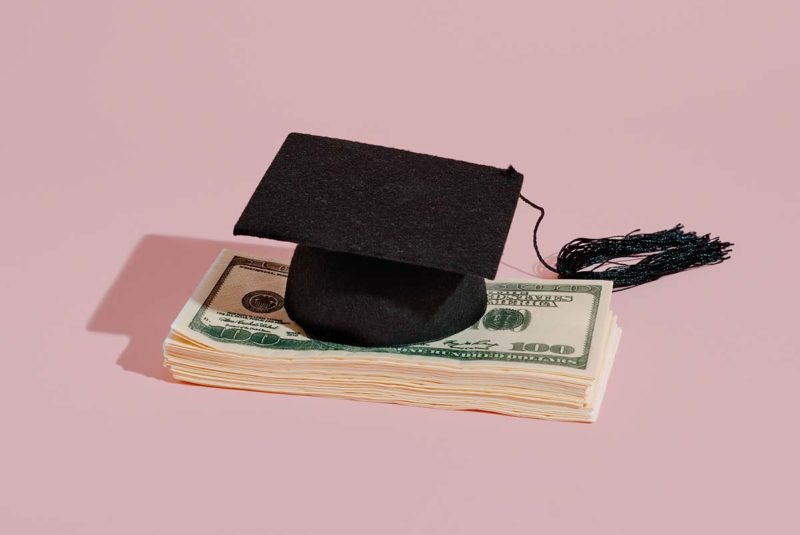An estimated 30% of American adults have incurred some kind of student loan debt,[1] but many of them may not realize what makes up their monthly student loan bill. Student loan payments include both principal and interest. But a good chunk of your payment might be going toward interest, not the loan’s principal.
Calculating your student loan interest comes down to a few simple formulas. By understanding how your payment is calculated and what your interest rate is, you can better strategize your student loan repayment schedule.
Whether you have a federal student loan or a private student loan, we’ve put together this guide to calculating your student loan interest so you can one day enjoy the benefits of your education debt-free.
How Is Student Loan Interest Calculated?
There are a few things to consider when you’re calculating your student loan interest, such as variable interest rates and simple or compound interest rates. You might have a federal, private or refinanced loan, and each likely has its terms and rates. Some of these terms can result in your monthly student loan interest and payments being lower or higher in the long term.
For example, federal student loans and many private student loans typically charge simple interest. Simple interest is interest applied to the loan’s principal amount.
Some private loans charge compound interest. Compound interest is interest applied to the loan’s principal and accrued interest (read: paying interest on your interest). Compound interest increases the amount of interest you pay over the life of the loan.
But, thanks to a few handy formulas, calculating monthly student loan interest and payments is fairly straightforward.
Student loan daily interest rate
The first step to calculating your student loan interest is to determine your daily interest rate. Interest rates for federal student loans are set by federal law. The interest rate for Direct Loans disbursed between July 1, 2022, and July 1, 2023, is 4.99% (up 3.63% from the previous year).[2]
To get the daily interest rate for your student loan, divide the loan’s annual interest by 365. Let’s say you took out a $15,000 federal student loan with a 3.73% annual simple interest rate. Here’s how you would calculate your daily interest rate:
Annual interest rate (4.99%) / 365 days in the year
0.0499 / 365 = 0.000137 = 0.0137%
So, your daily interest rate is 0.0137%.
Student loan daily interest charge
Once you’ve calculated the daily interest rate, you’ll apply it to your loan’s principal balance to determine the daily interest charge. It should look like this:
Principal loan amount ($15,000) x daily interest rate (0.000102) = $2.06
Student loan monthly payment
You can use the daily interest charge to figure out the monthly student loan interest payment. We’ll multiply the daily interest charge by the number of days between payments, which is generally 30 days. It looks like this:
Daily interest charge ($2.06) x days between payments (30 days) = $62
Your monthly student loan interest payment is $62.
Remember, we’re only figuring out the interest payment. Our result doesn’t include your principal payment. If you paid $62 every month, what you owe in principal would never change. If you only pay off the interest, your student loan balance won’t go down.
If you can pay more than the minimum interest payments, you can decrease your student loan debt faster. The more you pay down your principal balance, the less interest you’ll be charged because the principal balance gets smaller with every payment.
You can also make extra payments that go directly to the loan’s principal to fast-track your payoff and save money on daily interest charges.
What Is Simple vs. Compound Interest?
The Department of Education uses the simple daily interest formula to calculate interest on federal student loans. Interest is charged as a percentage of the loan’s principal balance.
Private loans sometimes use compound interest. With compound interest, the daily interest is applied to the principal balance and any unpaid, accumulated interest. While borrowers only pay interest on the principal for simple interest loans, they pay interest on the principal plus accrued interest for compound interest loans.
If you’re paying simple interest on your loans and making principal payments, each month, the interest will be applied to a lower principal amount, which means you’ll be charged less in interest each month. If you’re paying compound interest, interest will keep accruing and even increase your loan balance if your monthly payments don’t cover the interest.
In some cases, interest can start accruing before you’re obligated to start repaying the loan. This is a common scenario when loans are in a grace period or forbearance.
Let’s think back to our example of the $15,000 loan, but this time it has a 4.99% compound interest rate. Let’s say it’s day 2 of your billing cycle, and you want to pay off the entire loan balance.
To pay the loan off, you’ll need to make a payment that also covers the $2.06 daily interest charge, so you’d be writing a check for the grand total of $15,002.06.
Remember, interest adds up if it stays unpaid over years, months or even days.
Pro tip: Avoid compounding interest on your loan by paying the entire amount of accrued interest every billing cycle.
What Is Loan Amortization?
If you’re paying both the interest and principal amounts every month but don’t notice your monthly billing amount changing, your loan is likely amortized. When a loan is amortized, you pay both principal and interest with the same monthly payment on a set schedule.
In some cases, both federal and private loans spread monthly payments evenly across the loan’s repayment period. As you pay your loan, the amount of your payment applied to interest decreases while the amount applied to the principal amount increases to keep the monthly billing amount the same.
By following a loan amortization schedule, you slowly accelerate your repayment progress over time. Let’s say you got a $15,000 loan on a 10-year repayment schedule with a 4.99% interest rate. In the first month, the principal payment will be $96.65. and the interest payment will be $62.38 for a total payment of $159.02. In the last month, your monthly payment will still be $159.02, but $149.49 will be applied to the principal and 66 cents will be applied to interest.
What Are Ways I Can Tackle My Student Loan Payments?
Now that you have a better idea of how student loan interest works, consider a few strategies to pay off your loans faster and avoid unnecessary interest charges.
Loan consolidation
With loan consolidation, you can bundle all of your federal student loans into one big, happy monthly payment. The Department of Education can consolidate your federal loans for free with a few options, such as extended repayment plans with lower payments but longer terms.
Before you decide to consolidate, keep a few factors in mind, such as your ability to make higher monthly payments. You don’t need good credit to get a Direct consolidation loan. Just make sure not to miss any payments, missing payments will negatively affect your score.
If you opt to have your loans (federal and/or private loans) consolidated with a private lender (aka refinanced) to take advantage of fixed or variable interest rates, be aware that there may be fees to pay.
FYI: If you refinance your federal and/or private loans with a private lender, you may lose many of the borrower protections, like income-driven repayment plans and grace periods, that typically come with federal loans.
Income-driven repayment and other options for repayment
You can take advantage of income-driven repayment options to help you pay off your federal student loan faster, with terms that match your financial situation. For example, an income-driven repayment plan lets you make monthly payments based on what you earn. While you’ll have a longer repayment schedule than the standard 10-year repayment plan, income-based repayment helps make your student loan payments more affordable so you have enough money for your other needs – especially when you’re fresh out of school. You’ll make larger payments as you earn more.
There are four main income-driven repayment programs for federal student loans:
- Revised Pay As You Earn (REPAYE)
- Pay As You Earn (PAYE)
- Income-Based Repayment (IBR)
- Income-Contingent Repayment (ICR)
These programs take a percentage of your discretionary income each month for up to 25 years. At the end of your repayment term, your remaining student loan debt is forgiven.
Repayment plans are helpful options for people struggling with student loan debt but are trying to build a good credit score and save money.
Quick Math for Faster Student Loan Interest Payments
Figuring out federal student loan interest rates and charges is relatively easy math. We hope that with this guide in hand, you now know more about how to calculate student loan interest and have a better understanding of what makes up your monthly payments, whether your loans are federal or private.
If you’re interested in changing the terms of your student loan, talk to your lender to see what options might best suit your circumstances.
The Short Version
- Student loan payments include both principal and interest
- There are a few things to consider when you’re calculating your student loan interest, such as variable interest rates and simple or compound interest rates
- By understanding how your payment is calculated and what your interest rate is, you can better strategize your student loan repayment schedule
Federal Reserve System. “Report on the Economic Well-Being of U.S. Households in 2021.” Retrieved January 2023 from https://www.federalreserve.gov/publications/2022-economic-well-being-of-us-households-in-2021-student-loans.htm
Federal Student Aid. “Understand how interest is calculated and what fees are associated with your federal student loan.” Retrieved March 2022 from https://studentaid.gov/understand-aid/types/loans/interest-rates
U.S. Department of Education. “COVID-19 Emergency Relief and Federal Student Aid.” Retrieved January 2023 from https://studentaid.gov/announcements-events/covid-19




